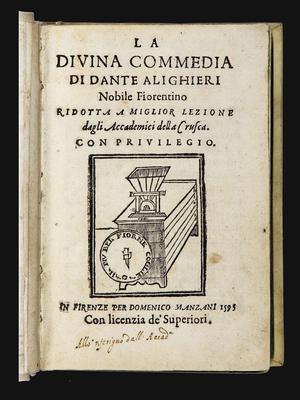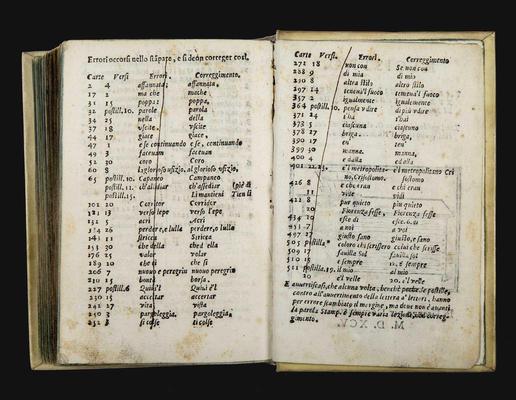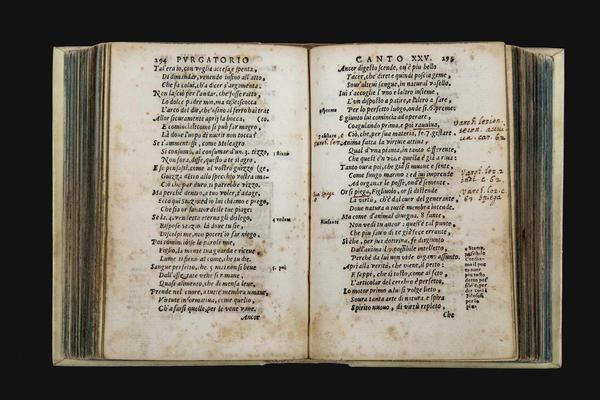Dante Alighieri
La Divina Commedia di Dante Alighieri Nobile Fiorentino ridotta a miglior lezione dagli Accademici della Crusca...
Florence, Domenico Manzani, 1595.8° (157x102 mm). Collation: †8, A-F8, G6, H-Z8, Aa-Mm8, Nn4. [16], 493 [i.e. 511], [53] pages, wanting fol. †8blank. Roman and italic type. Woodcut device of the Accademia della Crusca on the title-page; on the versoof the last leaf a different Crusca device. Fine woodcut initials, depicting the devices of various members of the Accademia della Crusca; head- and tailpieces. A woodcut map of Hell, based on AntonioManetti's iconographical diagram but now in a new design (backed and mounted, bound here as frontispiece). Eighteenth-century vellum, over pasteboards. Smooth spine, divided in compartments by gilt fillets, author'sname on painted label. Blue edges. A good copy, slight browning and spotting. An insignificant burn hole in the outer blank margin of fols. Z4-Aa1. Numerous corrections, underlinings and marginalia in Bastiano de' Rossi's own hand.
Provenance: Bastiano de' Rossi (b. ca. 1550; inked inscription on the title-page ‘Allo 'nferigno dall'Accada); Libreria Antiquaria Dotti, Roma (small label on the front pastedown); Livio Ambrogio collection.
The first edition of the Commedia edited by the renowned Florentine Accademia della Crusca – the first language academy in the world, founded in 1582 – in a precious presentation copy to its first secretary Bastiano de' Rossi, as attested by the manuscript note on the title-page ‘Allo ‘nferigno dall'Accada''. As is well-known, each member of the Accademia had to adopt an academic name, motto and emblem related to ‘crusca' (bran), and de' Rossi adopted the nickname, or nome di Crusca, of ‘Inferigno' – the ‘branny one', denoting a sort of bread baked with meal and bran (‘cruschello') – and the motto ‘per cominciare' (‘to begin'). He was among the editors of the 1595 Commedia, the result of the painstaking collation of about one hundred earlier manuscripts in order to improve the Aldine vulgata of 1502; 465 new readings were proposed, and variants were printed in the margin of the leaves. The aim of the Accademia was to promote Tuscan as a linguistic model, and a particular emphasis was placed on Dante and his vernacular poetry, in polemical opposition to the classicism professed by Pietro Bembo. This edition of the Commedia was undertaken in order to provide a source for the examples of correct usage which were to be inserted in the entries for the proposed Vocabolario degli Accademici della Crusca, which first appeared in 1612.
This copy of the so-called Commedia della Crusca is an example of the rare first state, distinguished by a different layout, the title ‘La Divina Commedia' instead of ‘La Divina Comedia', and the last quire with the errata consisting of just two pages instead of the six found in later issues. Furthermore, the volume contains numerous corrections of misprints and emendations in de' Rossi's hand, some of them referring to the fourteenthcentury commentary by Francesco da Buti.
The title-page displays the famous device of the Accademia della Crusca, showing a flour bolter with the motto ‘il più bel fior ne coglie' (i.e. ‘it picks the fairest flower'). The editorial revision of each canto was entrusted to different members of the Crusca itself, whose devices and mottoes are depicted in woodcut initials at the beginning of each canto. Bastiano was given the fifth canto of the Inferno to edit, and therefore it is the only one in this copy that does not have marginal and interlinear emendations in his own hand.
The copy presented here is a striking testimony to the laborious work undertaken by the Accademia della Crusca to restore a correct reading of Dante's text, providing what is in effect the first modern critical edition of the Commedia.




